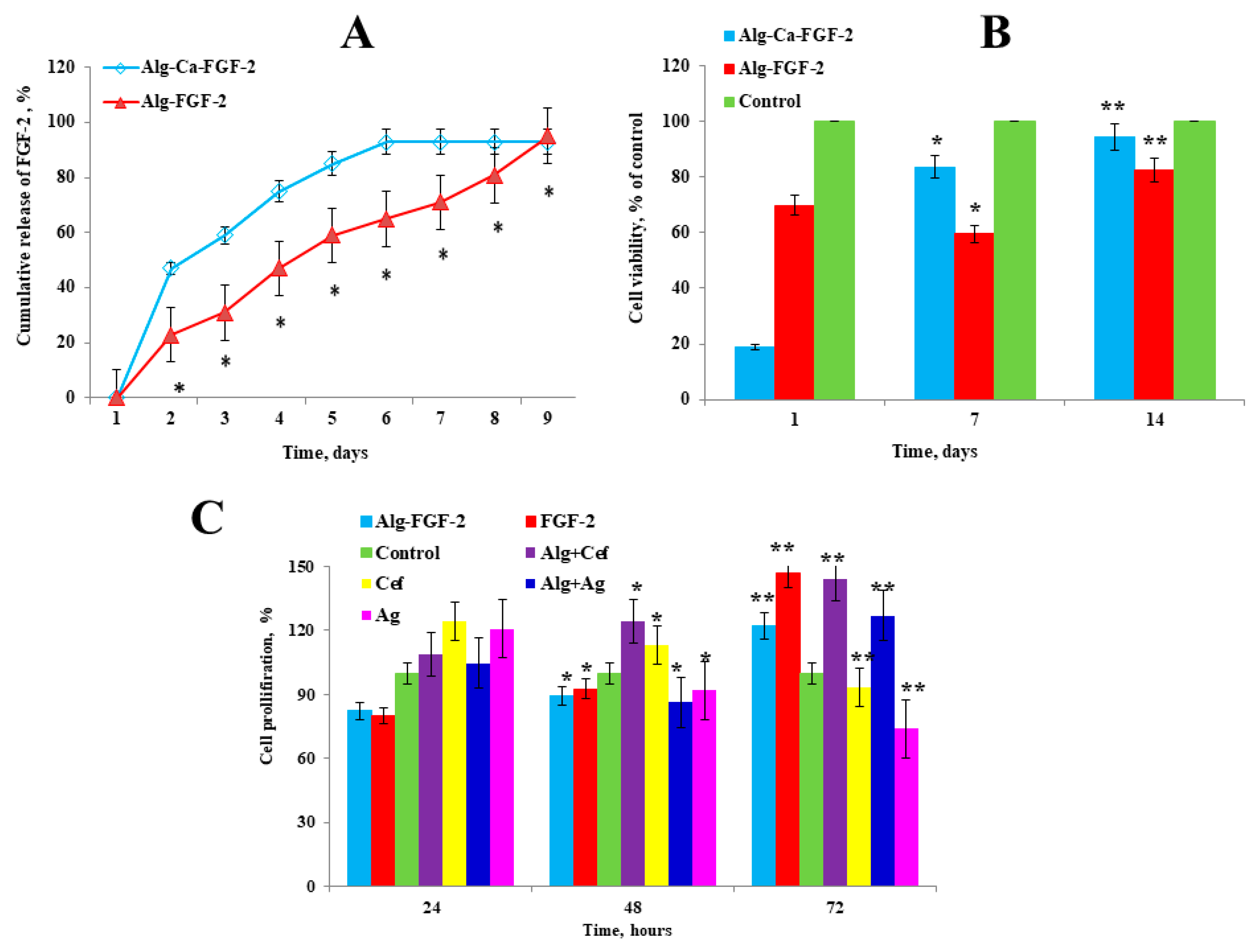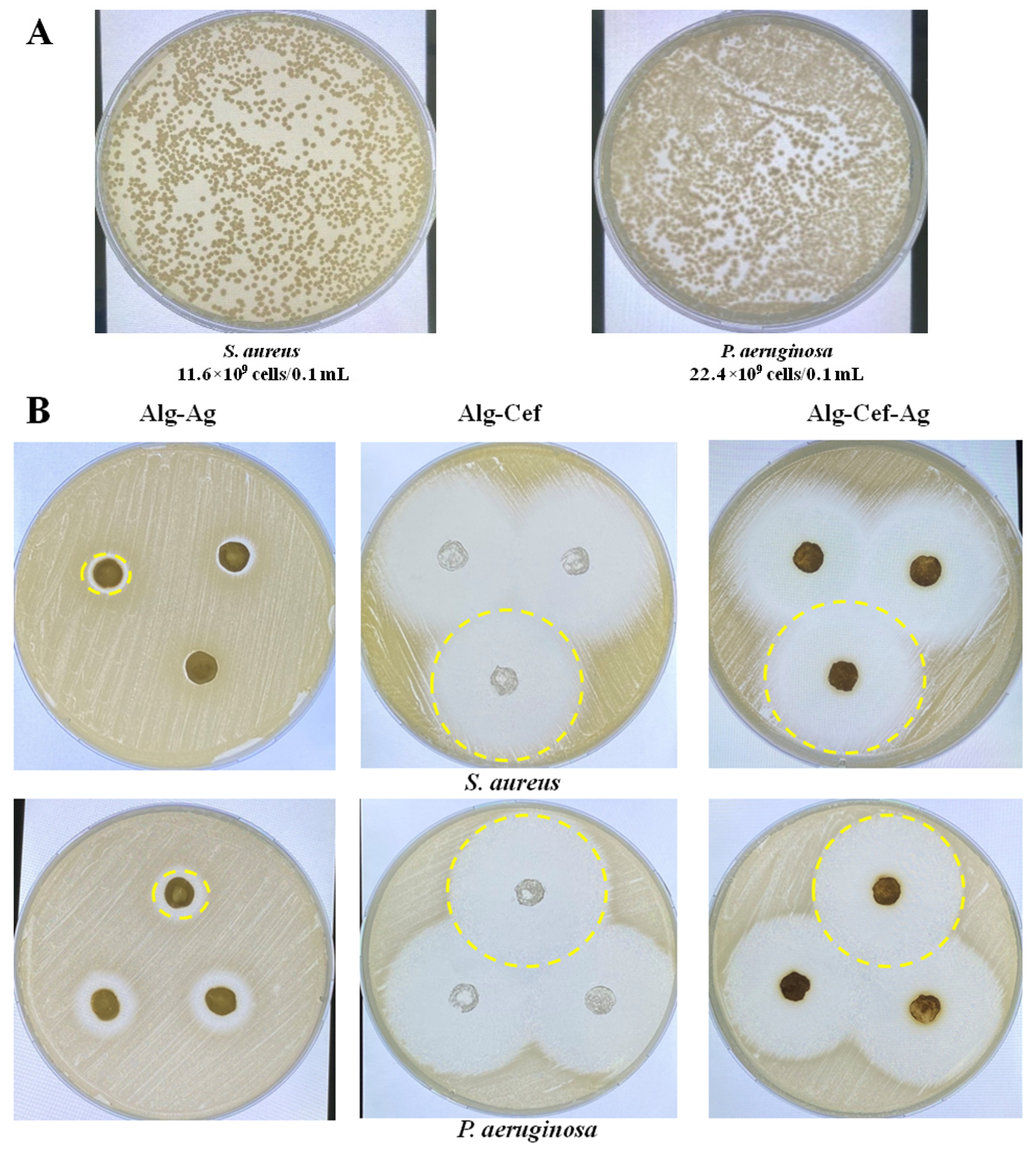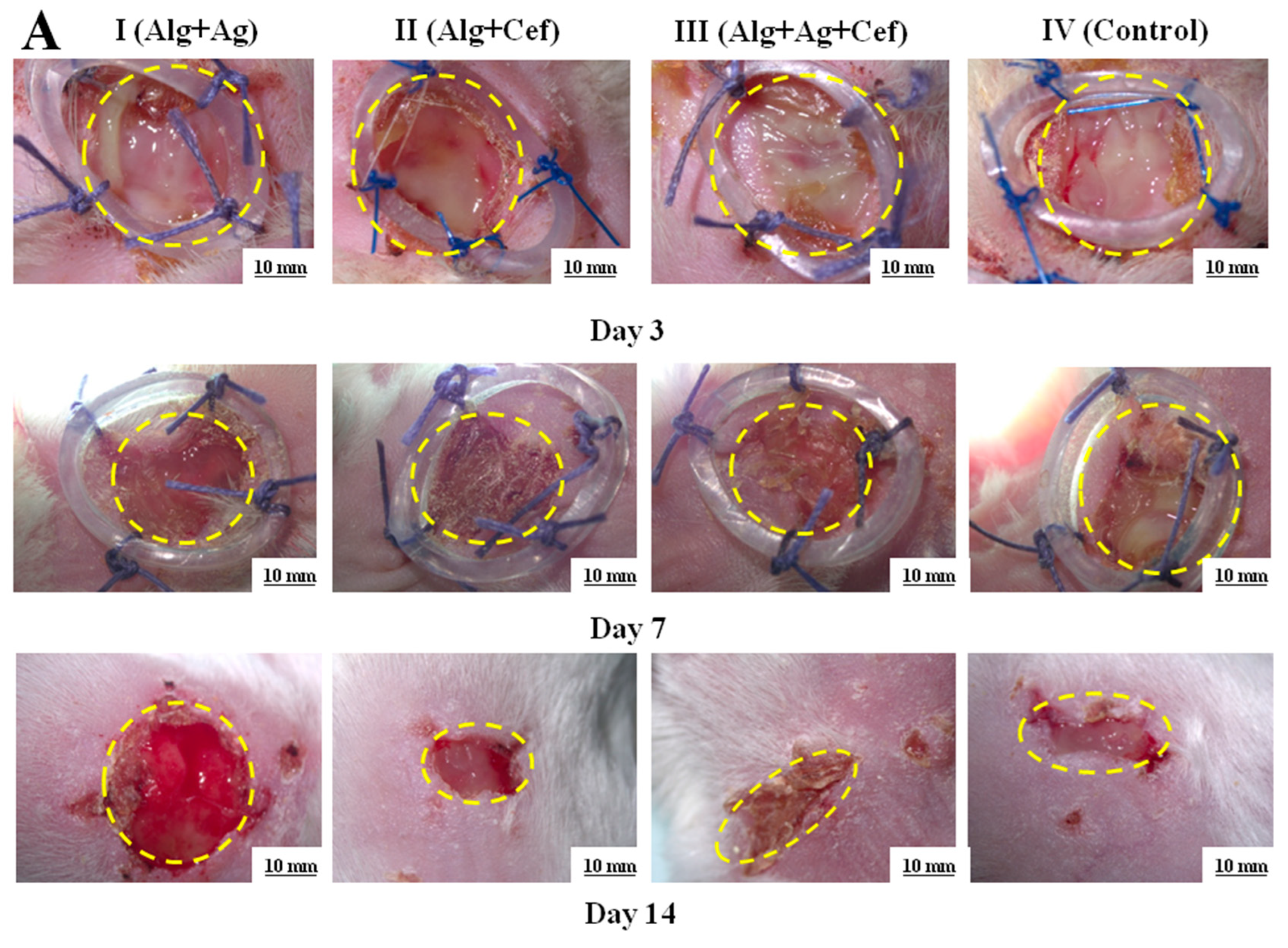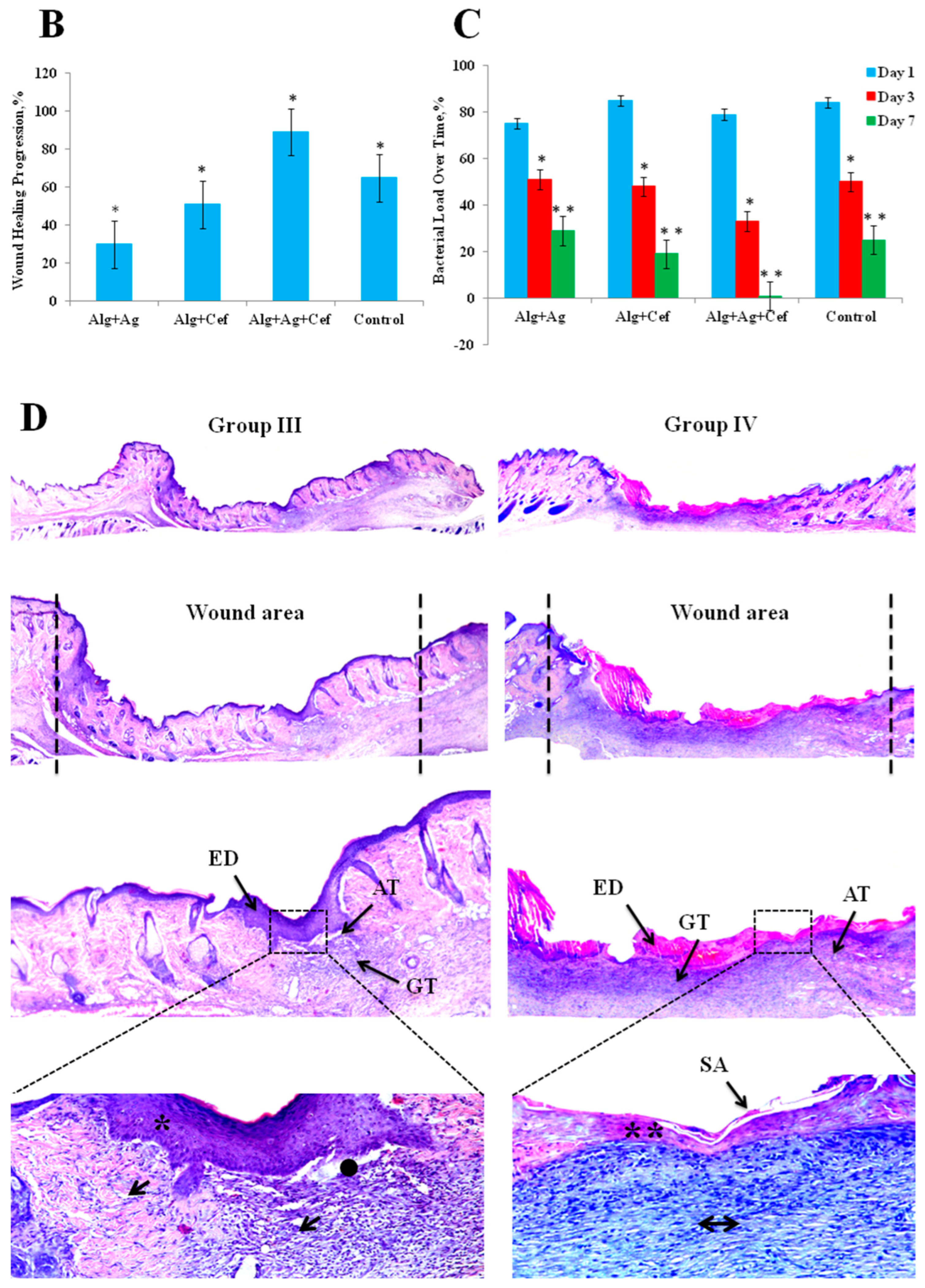Exploring the Antibacterial and Regenerative Properties of a Two-Stage Alginate Wound Dressing in a Rat Model of Purulent Wounds
Abstract
:1. Introduction
2. Materials and Methods
2.1. Animals
2.2. Materials
2.3. Synthesis of Alginate Dressings
2.4. Nuclear Magnetic Resonance
2.5. Scanning Electron Microscopy
2.6. FGF-2 Release Kinetics
2.7. MTT Assay
2.8. Analysis of Antibacterial Activity
- c is the sum of the counted colonies on all plates;
- is the number of plates of the first dilution;
- is the number of plates of the second dilution;
- is the coefficient of the first dilution;
- 0.1 is the coefficient accounting for the dilution factor of both the first and second dilutions.
2.9. Modeling a Purulent Wound in Rats (Location Selection)
- Experimental animals with purulent wound modeling (S. aureus + P. aeruginosa) with wounds created in the withers area.
- Experimental animals with purulent wound modeling (S. aureus + P. aeruginosa) with wounds created in the femoral–gluteal area.
2.10. Evaluation of the Safety and Efficacy of Two-Stage Therapy Using Alginate Dressings in Rats
- Experimental animals with purulent wound modeling (S. aureus + P. aeruginosa) using alginate dressings absorbed with silver particles;
- Experimental animals with purulent wound modeling (S. aureus + P. aeruginosa) using alginate dressings absorbed with the antibiotic cefepime;
- Experimental animals with purulent wound modeling (S. aureus + P. aeruginosa) using alginate dressings absorbed with silver particles and the antibiotic cefepime;
- Experimental animals with purulent wound modeling (S. aureus + P. aeruginosa) using the traditional method of treating purulent wounds—daily dressings with aseptic solutions and ointments.
2.11. Histological Analysis
2.12. Statistical Analysis
3. Results
3.1. Characterization of Alginate Hydrogel
3.2. Evaluation of the Safety and Efficacy of the Two-Stage Dressing in Rats
4. Discussion
5. Conclusions
Author Contributions
Funding
Institutional Review Board Statement
Informed Consent Statement
Data Availability Statement
Acknowledgments
Conflicts of Interest
References
- Shmatenko, O.P.; Pidlisny, O.V.; Prykhodko, T.V.; Solomennyi, A.M.; Pritula, R.L.; Semenchenko, G.B.; Takhtaulova, N.O. Technological aspects of creating soft dosage forms for the treatment of purulent wounds. Ukr. J. Mil. Med. 2020, 1, 50–63. [Google Scholar] [CrossRef]
- Zubarev, P.N.; Ivanus, S.Y.; Risman, B. V Modern Principles of Treatment of Purulent Wounds; Food and Agriculture Organization of the United Nations: Rome, Italy, 2017; Volume 37. [Google Scholar]
- Guo, S.; Dipietro, L.A. Factors Affecting Wound Healing. J. Dent. Res. 2010, 89, 219–229. [Google Scholar] [CrossRef]
- Medzhitov, R. Origin and Physiological Roles of Inflammation. Nature 2008, 454, 428–435. [Google Scholar] [CrossRef] [PubMed]
- Hotchkiss, R.S.; Karl, I.E. The Pathophysiology and Treatment of Sepsis. N. Engl. J. Med. 2003, 348, 138–150. [Google Scholar] [CrossRef]
- Vigata, M.; Meinert, C.; Hutmacher, D.W.; Bock, N. Hydrogels as Drug Delivery Systems: A Review of Current Characterization and Evaluation Techniques. Pharmaceutics 2020, 12, 1188. [Google Scholar] [CrossRef] [PubMed]
- Qu, J.; Zhao, X.; Liang, Y.; Xu, Y.; Ma, P.X.; Guo, B. Degradable Conductive Injectable Hydrogels as Novel Antibacterial, Anti-Oxidant Wound Dressings for Wound Healing. Chem. Eng. J. 2019, 362, 548–560. [Google Scholar] [CrossRef]
- Ogay, V.; Mun, E.A.; Kudaibergen, G.; Baidarbekov, M.; Kassymbek, K.; Zharkinbekov, Z.; Saparov, A. Progress and Prospects of Polymer-Based Drug Delivery Systems for Bone Tissue Regeneration. Polymers 2020, 12, 2881. [Google Scholar] [CrossRef]
- Wang, H.; Feng, Y.; Lu, H. Low-Level Cefepime Exposure Induces High-Level Resistance in Environmental Bacteria: Molecular Mechanism and Evolutionary Dynamics. Environ. Sci. Technol. 2022, 56, 15074–15083. [Google Scholar] [CrossRef]
- Shi, Q.; Luo, X.; Huang, Z.; Midgley, A.C.; Wang, B.; Liu, R.; Zhi, D.; Wei, T.; Zhou, X.; Qiao, M. Cobalt-Mediated Multi-Functional Dressings Promote Bacteria-Infected Wound Healing. Acta Biomater. 2019, 86, 465–479. [Google Scholar] [CrossRef]
- Re’em, T.; Witte, F.; Willbold, E.; Ruvinov, E.; Cohen, S. Simultaneous Regeneration of Articular Cartilage and Subchondral Bone Induced by Spatially Presented TGF-Beta and BMP-4 in a Bilayer Affinity Binding System. Acta Biomater. 2012, 8, 3283–3293. [Google Scholar] [CrossRef]
- Chen, K.; Wang, F.; Liu, S.; Wu, X.; Xu, L.; Zhang, D. In Situ Reduction of Silver Nanoparticles by Sodium Alginate to Obtain Silver-Loaded Composite Wound Dressing with Enhanced Mechanical and Antimicrobial Property. Int. J. Biol. Macromol. 2020, 148, 501–509. [Google Scholar] [CrossRef]
- Diniz, F.R.; Maia, R.C.A.P.; de Andrade, L.R.M.; Andrade, L.N.; Vinicius Chaud, M.; da Silva, C.F.; Corrêa, C.B.; de Albuquerque Junior, R.L.C.; Pereira da Costa, L.; Shin, S.R. Silver Nanoparticles-Composing Alginate/Gelatine Hydrogel Improves Wound Healing In Vivo. Nanomaterials 2020, 10, 390. [Google Scholar] [CrossRef]
- Lin, X.; Guan, X.; Wu, Y.; Zhuang, S.; Wu, Y.; Du, L.; Zhao, J.; Rong, J.; Zhao, J.; Tu, M. An Alginate/Poly (N-Isopropylacrylamide)-Based Composite Hydrogel Dressing with Stepwise Delivery of Drug and Growth Factor for Wound Repair. Mater. Sci. Eng. C 2020, 115, 111123. [Google Scholar] [CrossRef]
- Zhang, M.; Zhao, X. Alginate Hydrogel Dressings for Advanced Wound Management. Int. J. Biol. Macromol. 2020, 162, 1414–1428. [Google Scholar] [CrossRef]
- Aderibigbe, B.A.; Buyana, B. Alginate in Wound Dressings. Pharmaceutics 2018, 10, 42. [Google Scholar] [CrossRef] [PubMed]
- Boateng, J.; Catanzano, O. Advanced Therapeutic Dressings for Effective Wound Healing—A Review. J. Pharm. Sci. 2015, 104, 3653–3680. [Google Scholar] [CrossRef]
- Yang, K.; Han, Q.; Chen, B.; Zheng, Y.; Zhang, K.; Li, Q.; Wang, J. Antimicrobial Hydrogels: Promising Materials for Medical Application. Int. J. Nanomed. 2018, 13, 2217–2263. [Google Scholar] [CrossRef]
- Zhang, H.; Peng, M.; Cheng, T.; Zhao, P.; Qiu, L.; Zhou, J.; Lu, G.; Chen, J. Silver Nanoparticles-Doped Collagen–Alginate Antimicrobial Biocomposite as Potential Wound Dressing. J. Mater. Sci. 2018, 53, 14944–14952. [Google Scholar] [CrossRef]
- Alshammari, F.; Alshammari, B.; Moin, A.; Alamri, A.; Al Hagbani, T.; Alobaida, A.; Baker, A.; Khan, S.; Rizvi, S.M.D. Ceftriaxone Mediated Synthesized Gold Nanoparticles: A Nano-Therapeutic Tool to Target Bacterial Resistance. Pharmaceutics 2021, 13, 1896. [Google Scholar] [CrossRef] [PubMed]
- Farhadian, N.; Karimi, M.; Porozan, S. Ceftriaxone Sodium Loaded onto Polymer-Lipid Hybrid Nanoparticles Enhances Antibacterial Effect on Gram-Negative and Gram-Positive Bacteria: Effects of Lipid-Polymer Ratio on Particles Size, Characteristics, In Vitro Drug Release and Antibacterial Drug Ef. J. Drug Deliv. Sci. Technol. 2021, 63, 102457. [Google Scholar]
- Adil, M.; Alam, S.; Amin, U.; Ullah, I.; Muhammad, M.; Ullah, M.; Rehman, A.; Khan, T. Efficient Green Silver Nanoparticles-Antibiotic Combinations against Antibiotic-Resistant Bacteria. AMB Express 2023, 13, 115. [Google Scholar] [CrossRef]
- Han, S.-K. Innovations and Advances in Wound Healing; Springer: Berlin/Heidelberg, Germany, 2023; ISBN 9811998051. [Google Scholar]
- Dolati, S.; Yousefi, M.; Pishgahi, A.; Nourbakhsh, S.; Pourabbas, B.; Shakouri, S.K. Prospects for the Application of Growth Factors in Wound Healing. Growth Factors 2020, 38, 25–34. [Google Scholar] [CrossRef] [PubMed]
- Kim, S.-W.; Im, G.-B.; Jeong, G.-J.; Baik, S.; Hyun, J.; Kim, Y.-J.; Pang, C.; Jang, Y.C.; Bhang, S.H. Delivery of a Spheroids-Incorporated Human Dermal Fibroblast Sheet Increases Angiogenesis and M2 Polarization for Wound Healing. Biomaterials 2021, 275, 120954. [Google Scholar] [CrossRef]
- Kuhn, L.T.; Peng, T.; Gronowicz, G.; Hurley, M.M. Endogenous FGF-2 Levels Impact FGF-2/BMP-2 Growth Factor Delivery Dosing in Aged Murine Calvarial Bone Defects. J. Biomed. Mater. Res. Part A 2021, 109, 2545–2555. [Google Scholar] [CrossRef] [PubMed]
- Dinh, T.; Braunagel, S.; Rosenblum, B.I. Growth Factors in Wound Healing: The Present and the Future? Clin. Podiatr. Med. Surg. 2015, 32, 109–119. [Google Scholar] [CrossRef]
- Hayes, A.J.; Whitelock, J.; Melrose, J. Regulation of FGF-2, FGF-18 and Transcription Factor Activity by Perlecan in the Maturational Development of Transitional Rudiment and Growth Plate Cartilages and in the Maintenance of Permanent Cartilage Homeostasis. Int. J. Mol. Sci. 2022, 23, 1934. [Google Scholar] [CrossRef]
- Novais, A.; Chatzopoulou, E.; Chaussain, C.; Gorin, C. The Potential of FGF-2 in Craniofacial Bone Tissue Engineering: A Review. Cells 2021, 10, 932. [Google Scholar] [CrossRef]
- Abayev, U. Wound Dressings in Surgery. Med. News 2003, 12, 30. [Google Scholar]
- Akhmetkarimova, Z.S.; Kudaibergen, G.K.; Kaukabaeva, G.K.; Abeldenov, S.K.; Rysbek, A.B. Thiol-Ene Click Synthesis of Alginate Hydrogels Loaded with Silver Nanoparticles and Cefepime. Eurasian J. Chem. 2023, 28, 110. [Google Scholar] [CrossRef]
- Zafar, N.; Shamaila, S.; Nazir, J.; Sharif, R.; Shahid Rafique, M.; Ul-Hasan, J.; Ammara, S.; Khalid, H. Antibacterial Action of Chemically Synthesized and Laser Generated Silver Nanoparticles against Human Pathogenic Bacteria. J. Mater. Sci. Technol. 2016, 32, 721–728. [Google Scholar] [CrossRef]
- Kudaibergen, G.; Akhmetkarimova, Z.; Yildirim, E.; Baidarbekov, M. Thiol-Ene Clickable Gelatin–Hyaluronic Acid Cryogels. J. Mater. Sci. 2023, 58, 10821–10831. [Google Scholar] [CrossRef]
- ISO 10993-5:2009(E); Tests for In Vitro Cytotoxicity. ISO: Geneva, Switzerland, 2009.
- Balouiri, M.; Sadiki, M.; Ibnsouda, S.K. Methods for In Vitro Evaluating Antimicrobial Activity: A Review. J. Pharm. Anal. 2016, 6, 71–79. [Google Scholar] [CrossRef] [PubMed]
- Adamiak, K.; Sionkowska, A. State of Innovation in Alginate-Based Materials. Mar. Drugs 2023, 21, 353. [Google Scholar] [CrossRef] [PubMed]
- Rosiak, P.; Latanska, I.; Paul, P.; Sujka, W.; Kolesinska, B. Modification of Alginates to Modulate Their Physic-Chemical Properties and Obtain Biomaterials with Different Functional Properties. Molecules 2021, 26, 7264. [Google Scholar] [CrossRef] [PubMed]
- Bruna, T.; Maldonado-Bravo, F.; Jara, P.; Caro, N. Silver Nanoparticles and Their Antibacterial Applications. Int. J. Mol. Sci. 2021, 22, 7202. [Google Scholar] [CrossRef]
- Grambow, E.; Sorg, H.; Sorg, C.G.G.; Strüder, D. Experimental Models to Study Skin Wound Healing with a Focus on Angiogenesis. Med. Sci. 2021, 9, 55. [Google Scholar] [CrossRef]






| Strains/Samples | Alg-Ag | Alg-Ag-Cef | Alg-Cef |
|---|---|---|---|
| P. aeruginosa | 3.5 ± 0.5 | 41.3 ± 0.4 | 38.1 ± 0.9 |
| S. aureus | 2.0 ± 0.4 | 36.6 ± 1.8 | 30.1 ± 0.5 |
Disclaimer/Publisher’s Note: The statements, opinions and data contained in all publications are solely those of the individual author(s) and contributor(s) and not of MDPI and/or the editor(s). MDPI and/or the editor(s) disclaim responsibility for any injury to people or property resulting from any ideas, methods, instructions or products referred to in the content. |
© 2024 by the authors. Licensee MDPI, Basel, Switzerland. This article is an open access article distributed under the terms and conditions of the Creative Commons Attribution (CC BY) license (https://creativecommons.org/licenses/by/4.0/).
Share and Cite
Atepileva, A.; Ogay, V.; Kudaibergen, G.; Kaukabaeva, G.; Nurkina, A.; Mukhambetova, A.; Balgazarov, S.; Batpen, A.; Saginova, D.; Ramazanov, Z.; et al. Exploring the Antibacterial and Regenerative Properties of a Two-Stage Alginate Wound Dressing in a Rat Model of Purulent Wounds. Biomedicines 2024, 12, 2122. https://doi.org/10.3390/biomedicines12092122
Atepileva A, Ogay V, Kudaibergen G, Kaukabaeva G, Nurkina A, Mukhambetova A, Balgazarov S, Batpen A, Saginova D, Ramazanov Z, et al. Exploring the Antibacterial and Regenerative Properties of a Two-Stage Alginate Wound Dressing in a Rat Model of Purulent Wounds. Biomedicines. 2024; 12(9):2122. https://doi.org/10.3390/biomedicines12092122
Chicago/Turabian StyleAtepileva, Aliya, Vyacheslav Ogay, Gulshahar Kudaibergen, Guldarigash Kaukabaeva, Assiya Nurkina, Ainur Mukhambetova, Serik Balgazarov, Arman Batpen, Dina Saginova, Zhanatay Ramazanov, and et al. 2024. "Exploring the Antibacterial and Regenerative Properties of a Two-Stage Alginate Wound Dressing in a Rat Model of Purulent Wounds" Biomedicines 12, no. 9: 2122. https://doi.org/10.3390/biomedicines12092122







